
|

|
Forum Index : Windmills : My new mill
| Author | Message | ||||
| VK4AYQ Guru Joined: 02/12/2009 Location: AustraliaPosts: 2539 |
Hi Jim I have decreased the tail weight by 2 pounds by fitting the larger tail sheet which is alloy, as compared to the original one which was steel New tail: 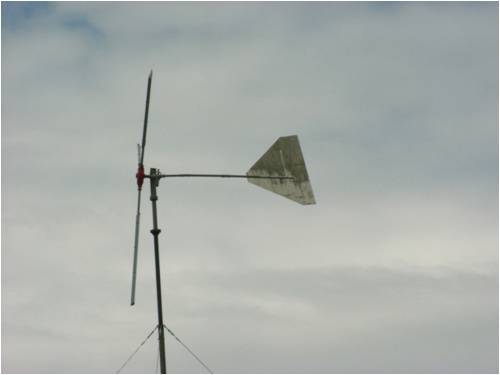
Original Tail: 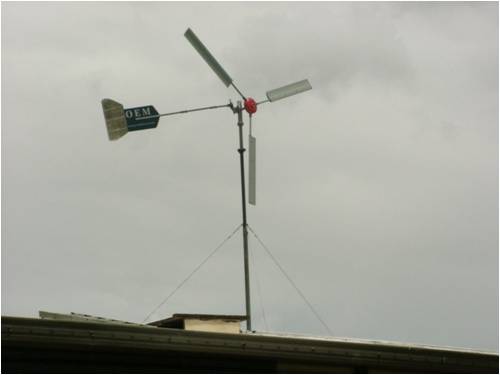
The original one in this configuration was also 6 inches longer adding to the tail weight. If you will note the lay back in the tail pivot you can see that it has a lot of lift, on trying to move it by hand in-situ I found it nearly impossible to move as Phill suggested. On reading up on furling angles it looks like the Chinese have put to much angle on the pivot thereby increasing the moment of force required to overcome the lift of the tail, like adding more weight. Phill has recommended reducing the lift angle, so I will make a jig and try the difference in foot pounds torque required to lift the tail as it would be when furled. One other thing I have noted is the tightness in the bush that the tail pivot rotates in, as it is new and hasn't run in yet so I think that will effect the furling as well. When they welded the bush it has distorted slightly and tightened on the shaft, I will try honing it for a better fit and a polish on the shaft that looks like it was turned down by a rusty nail, it all adds friction to the system. When I tried it initially it wasn't to bad but didn't have the tail weight hanging on it, it probably needs a couple of ball bearings on a larger housing to reduce friction or a brass bush not steel to steel. I did try the smaller tail approach but the mill became unstable and wandered around all the time coming in and out of wind, but not furling. Sorry I can't do a video as my camera has only a 10 second video clip facility so not much use. All the best Bob Foolin Around |
||||
| Jarbar Senior Member Joined: 03/02/2008 Location: AustraliaPosts: 224 |
Bob,been following with interest your project. I just tried an old trick from my cycle shop days,and that is to spin a bike wheel and then support under the axle at one end. The gyroscopic force keeps the wheel from falling down but spinning CW looking from the front or unsupported end of axle has a tendency to turn to the right and ACW to the left. This turning action is no doubt considerable with your blade diameter. Try this yourself and I think it will support Pete's observation. Anthony "Creativity is detirmined by the way you hold your tounge".My Father "Your generation will have to correct the problems made by mine".My Grandfather. |
||||
| VK4AYQ Guru Joined: 02/12/2009 Location: AustraliaPosts: 2539 |
Hi Anthony Let me get this clear, if the wheel is spinning ccw looking from the supported axle it wants to turn to the left which would be the furling action, if I got this right it is opposite to Pete's theory, when it stops raining I will see if I can find a wheel and give it a try. If I run the mill the other way I will have to get some left hand rectifiers He He 
All the best Bob Foolin Around |
||||
| isaiah Guru Joined: 25/12/2009 Location: United StatesPosts: 303 |
HEY All Its 2011 now up here in Yankee land. '  ' '
Bob no just turn the rectifiers around and wire them from the other side '  ' '
You may have to use a left handed soldering iron though!! URL=http://www.motherearthnews.com/Renewable-Energy/1973-11- 01/The-Plowboy-Interview.aspx>The Plowboy Interview[/URL> |
||||
| Jarbar Senior Member Joined: 03/02/2008 Location: AustraliaPosts: 224 |
Bob,from the description you describe the wheel turns to the right,the opposite to the furling action. Anthony. "Creativity is detirmined by the way you hold your tounge".My Father "Your generation will have to correct the problems made by mine".My Grandfather. |
||||
| VK4AYQ Guru Joined: 02/12/2009 Location: AustraliaPosts: 2539 |
Hi Isaiah Thanks for the info on the rectifiers if I have to change rotation Ill do that, already have a left hand soldering iron I purchase as an apprentice when sent to the tool supplier to get one by the boss, could never understand why he was unhappy with the invoice, as ho ordered it, I moved on before he got the long weight I ordered for him, he was a real grumble bum. All the best Bob Foolin Around |
||||
| VK4AYQ Guru Joined: 02/12/2009 Location: AustraliaPosts: 2539 |
Hi Anthony Looking from the tail vane (rear) of the mill the blades turn ccw and the mill furls to the left, I have looked at a few different designs and that seems to be a standard in the small mills, got into big strife with the wife when I took the wheel off her exercise bike, no sense of humor at all, my bike had a flat tire so was a bit wonky. I will keep trying and let you know. All the best Bob Foolin Around |
||||
| VK4AYQ Guru Joined: 02/12/2009 Location: AustraliaPosts: 2539 |
Progress Report I put the mill back up and two hours later I had one of the worst storms for a long time 3 + inches of rain and lightning and thunder in a continuous burst for nearly two hours, The mill survived the storm and appeared to be furling in a controlled fashion, while it was difficult to see exactly what was happening due to the heavy rain, I could see the blades slowing down then speeding up as the gusts went through, the blades went from full speed back to about 60 to 80 rpm then speeding up again. The rain was so heavy I couldn't see the angle relationship to the blades so dont know the exact motion of the furling, but, I think to bring the blade speed down as much as it did it must be near fully furled. The angles used on the head are 5.5 degrees lay back and 9 degrees to the side, I was aiming for 5 degrees back and 10 to the side but welding changed things a bit. I reduced the weight of the blades by a total of 1.4 KG by cutting the steel tube in the blade off just past the second bolt taking 12 inches from the tube. Looking at the action of the blades they accelerate a little quicker and slow quicker due to less inertia, as the weight reduction means a weight reduction of 30% at the center of gravity of the blade, and as the weight was on the outside of the rotational plane it would mean a significant reduction in the moment of inertia of the turbine. A more careful balancing has removed any vibration from the blades. The machining of the stator to a perfect round in relation to the rotation of the rotor gap solved the growl that was noted at low speed cut in, it is now a gentle and even hum, so thats a big improvement. The air gap is now .016 thousands of an inch or about .4 mm. The extra air gap hasn't made any significant increase to the cut in and it starts charging at 120 rpm one amp through the boost module for 10 volts AC from the mill. Below that it still charges a bit starting at 3.5 volts AC only 85 ma but it is working. How much did it put out during the storm? I don't know because I wasn't silly enough to go out in the storm to watch the meters, that will have to wait for better weather. 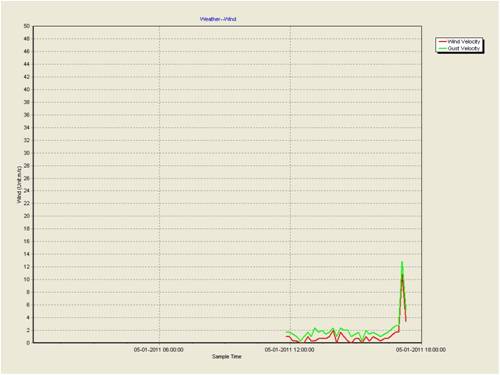
This graph is from the time I put the mill up to the storm, the first high peak is the start of the storm but the lightning zapped the radio link to the weather station so it didn't record the full event but it did get worse from there. All the best Bob Foolin Around |
||||
Downwind Guru Joined: 09/09/2009 Location: AustraliaPosts: 2333 |
Think you should put some lightning rods and find a way to convert it to DC, as you get more lightning than wind there by the sounds of it. 
You could then change your name to the lightning god. (what was his name?) Or is it because you have been a bad boy and the gods are unhappy with you. 
Pete. Sometimes it just works |
||||
| VK4AYQ Guru Joined: 02/12/2009 Location: AustraliaPosts: 2539 |
Hi Pete I could make some big caps and hook them to the shed roof and that would stop every storm within 50 miles. I think he was called Thor, because he had a Thor hand from throwing lightning bolts. The third reason is the most probable conclusion, this trying to steal sunlight and energy from the wind really upsets them. It also could be bad luck because if it was raining blonde film stars I would be hit by Lassie or a puff. You cant beat bad luck the world is full of it, and that as well. All the best Bob Foolin Around |
||||
| shawn Senior Member Joined: 30/03/2010 Location: New ZealandPosts: 210 |
Its almost funny how we think fondly of (mother nature) she feeds us she keeps us warm she provides us everything we need to survive, But like most woman man she can be hard on our toys!!!   
on a diferent note you seem to have done a terific job fixing this mill top marks to ya   but i can't help think with all the effort why not just put together your own? you have all the knowhow required otherwise your mill would be dead by now. but i can't help think with all the effort why not just put together your own? you have all the knowhow required otherwise your mill would be dead by now. |
||||
| VK4AYQ Guru Joined: 02/12/2009 Location: AustraliaPosts: 2539 |
Hi Shawn This was a labor of love as I love to fix things and modify them, It started out as good little mill at a reasonable price with potential for low wind recovery of energy which is what is needed at my place, from that point of view I am very happy with it, and it cost less than the magnets for my AXFX machine. Between Murphy and mother nature it is amazing that we get anything going. Once I am sure the furling is working OK I will be happy and start on the next project a LG unit with 3.7 meter blades and a shonky power system as I have all the parts for that. The AXFX will have to wait a bit until I get some funds together, and get the power system sorted out on the LG as that will determine the voltage I wind it for. More on that later. You keep up the good work on yours as it is a good project and very interesting and informative also. All the best Bob Foolin Around |
||||
| VK4AYQ Guru Joined: 02/12/2009 Location: AustraliaPosts: 2539 |
Hi All It was a bit dryer today and I had a chance to do a guage gaze with a good slow and consistent wind speed to asses the usefulness of the boost controller, the following is the wind and gust graph. 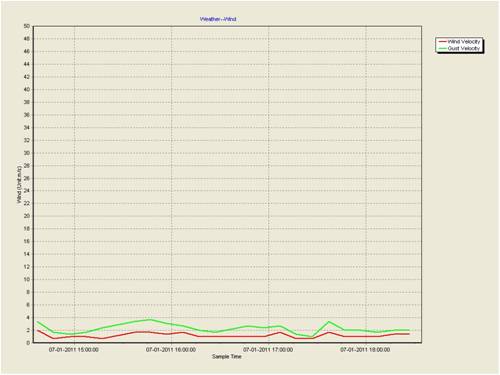
Not impressive in the way of wind but it is proof of concept for the boost module, during this time the mill output was fluctuating between 500 ma and 1.5 amps on the boost module and just starting to feed through the cap doubler. just under 1 amp on peak gusts. The combination of these two devices pull every last watt out of the mill. The figures are higher than the Altons simulator and I put this down to the efficiency of these blades at low speed. Others may disagree with me but I know what I am seeing, unfortunately I cant log it for you all but that will come in the future. All the best Bob Foolin Around |
||||
| VK4AYQ Guru Joined: 02/12/2009 Location: AustraliaPosts: 2539 |
Blade efficiency Horses for courses. This morning I have been observing the results of low wind on my two wind mills, the Old mill a 500 watt Chinese mill with a set of upgraded composite blades 2.5 meters in diameter, and My new mill which has the extruded alloy blades ge222 profile as supplied with the mill 2.8 meters dia. My old mill blades are more theoretically efficient as they are tapered and pitch twisted and generally what would be considered to be a better profile, and once they get going they can produce a lot of power, in high winds I have seen the amp meter pegged at 50 amps nearly 1600 watts not bad out of an old 500 watt mill. 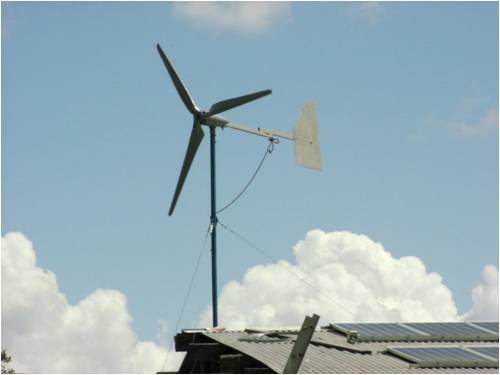
My new mill blades are a constant cord blade with no twist for pitch compensation, wide cord right to the tip a high lift, high drag airfoil profile,GE 222 all in all a theoretically less efficient blade set, and they have a big aerodynamic hole in the swept area due to the blades not going right to the hub. The performance of these blades is exceptional though, they are quite happy to start below 1 ms average wind speed if a slight gust starts the moving, once moving they produce power, consistently in excess of the Alton example, they are producing electrical energy at 80 RPM 1.4 ms 1 amp into 27 volts while the more efficient blades on my old mill are still sitting still, and by 120 rpm around 2 amps into 27 volts, the more efficient blades are just starting at that producing nothing, they are .3 meter smaller in diameter so a smaller swept area comes into play. 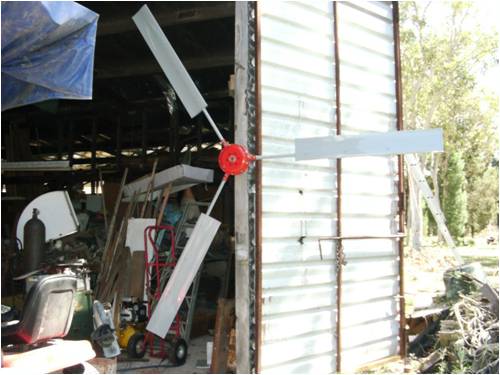
Other Issues with the comparison. The new mill blades load up better to produce more torque as the amp meter goes up rapidly whereas The more efficient blades have to speed up a lot more. Once again here is a difference in alternator construction with the old mill quoting a cut in of 3.5 ms as compared to a quoted 3 ms for the new mill, and its design is a far better design for slow speed power production even wired in Delta. The other aspect of this is overspeeding, the new blades run a lot slower due to their perceived inefficiency, but to me this is an advantage as they produce more than enough torque to drive the alternator, twice over but are less inclined to overspeed, In the same wind the blades on the old mill are really whistling around while the new mill blades are fast but not excessive speed, this was prior to the furling exercise. In summery it is a bit like comparing apples with walnuts from an alternator point of view but a close competition when comparing blade usefulness. For our size turbines I believe these blades are an ideal choice for turbines running at speeds up to 700 rpm. Their perceived inefficiency from a technical point of view appears to me to be an advantage. This is only my observation from a practical point of view and no doubt some will disagree and thats great with me as we all learn from one another. next I hope to ser up to identical alternators with the two types of blades, side by side with a logger on each and compile a direct blow by blow comparison. Sorry for waffling on so much. All the best Bob Foolin Around |
||||
| shawn Senior Member Joined: 30/03/2010 Location: New ZealandPosts: 210 |
Your waffling is good we all learn from it! very interesting!! I am thinking that there will be a point when the (better) profile will take over and produce better power but if this is in the high wind zone there is no point for me anyway because i only want to charge batteries, and in high wind its no problem! Grid connected and a good wind site it might be a different scenario and the better profile would be best. |
||||
| Gizmo Admin Group Joined: 05/06/2004 Location: AustraliaPosts: 5078 |
Good waffle Bob. I think sometimes there is too much emphasis on blade/turbine efficiency. Its true the GEO222 blades dont make the most efficient turbine on paper, but from a practical point of view, they are a good all rounder. Easy to use and lots of low down power, with good power up in the higher speeds. A efficient turbine, with twisted tapered light blades can give more power, when coupled with a matching alternator, no doubt. But for most of us, a turbine built around the GEO222 will work better. What using the GEO222 does mean is alternator/turbine matching isn't as critical as it is with a higher performance blades, we can get away with a less finely tuned machine and still get excellent results. I think if you have the time and resources, then making your own twisted tapered blades is the way to go, especially for larger machines over 3 to 4 meters diameter. But for anything smaller, the GEO222 will do just fine. Glenn The best time to plant a tree was twenty years ago, the second best time is right now. JAQ |
||||
| JimBo911 Senior Member Joined: 26/03/2009 Location: United StatesPosts: 262 |
To all Concerned I have tryed changing the angle of attack with the GEO222 blades. In my experiences as the blades spin up and reach a certain RPM (RPM unknown)there is a noticiable and or very distinct jump or increase in RPM this I assume is when the lift affect takes hold or kicks in, the angle of attack is set at a minimum or at a lower angle and they run very quiet. At a lower angle it takes a higher wind speed for them to start spinning from standing still. Increasing the angle of attact will cause them to begin spinning at lower wind speeds and will produce more low end torque. Running at increased angles will reduce lift affect and cause more drag which also creates more noise but helps keep RPM down. My anemometer has extra large cups and is designed to respond to light winds, more often then not my mill responds to varying wind speeds sooner the anemometer. When not loaded the blades will continue to spin with what seems to be very little or no wind at all but then responds quickly when a slight breeze comes in. My neighbor flys a Skystream 3.7 at 75 feet/22.86 meters and if the winds are out of the west my mill will almost allways spin before his Skystream does. Over all I am very pleased with there performance. My mill topped out at 690 watts, single stator F&P, neo mags, 2 meter blade set. Jim |
||||
| VK4AYQ Guru Joined: 02/12/2009 Location: AustraliaPosts: 2539 |
Hi jim I have found the same effect with my blades, as they pick up speed they unstall and from then on produce serious power, I use a angle of attack of eight degrees That is 12 degrees across the bottom to give a cord line angle of 8 degrees. At that angle the blades run very Quiet and produce power from 100 rpm with the boost module. The locating pin on the inner end of the blade holds the shaft. 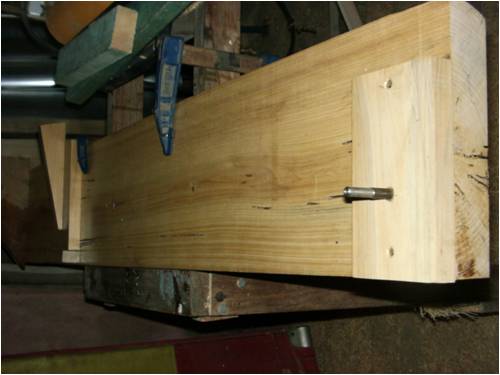
The blade rests in the angle which is cut at 12 degrees to give 8 degrees at the cord line. 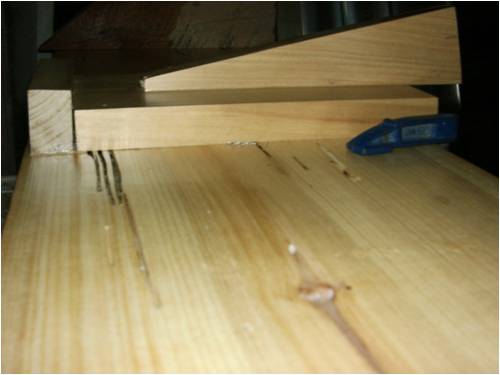
I tried more pitch but the blades where sluggish, and with less pitch they where hard to start and didn't produce as much torque so Phill's recommendation was spot on. Mine are 2.8 meter diameter and produce power from 80 rpm even if its just a couple of hundred milliamp. The boost module loads the blades a bit and slows their acceleration but I don't mind as it is producing power where there was none before. Your single stator producing 690 watts is very good as a lot of the conversions are only getting that from dual stator, but i suspect the Neo magnets are the trick to that. All the best Bob Foolin Around |
||||
| VK4AYQ Guru Joined: 02/12/2009 Location: AustraliaPosts: 2539 |
Hi glenn I must agree with you on the versatility of this profile, as it does produce the goods at low wind speed which is what we have most times, and as Gordon says, the low speed performance of the mill is where they spend 90 % of their time, so to get the best there is more important than efficiency at high wind speeds where a fence paling will overdrive our size alternators let alone a super efficient profile, that in fact is more prone to overspeed and can be be more difficult to control so it doesn't burn the coils out in the AXFX or run a conventional alternator to saturation. If we didn't have practical limitations on our turbine size, such as a huge commercial turbine, the best and most efficient blades that can absorb all the energy from the airflow would be a tapered and pitch corrected blade, but where we are the best blade is one that fits our pocket and does the job of producing 2 to 3 KW. Both my mills survived the horrendous storms in the last two days with gusts measured on the ground to 40 ms as the weather was just too bad to go and watch meters in the shed I cant say what they where producing but on past experience, I believe that old mill was over 1 KW and the new mill around 1.5 KW before furling. All the best Bob Foolin Around |
||||
| VK4AYQ Guru Joined: 02/12/2009 Location: AustraliaPosts: 2539 |
Hi Shawn If you site is blessed with high wind you have got it made and the profile isn't so important except if it is trying to overspeed all the time which isn't good for XAFX mills, then the furling is very critical to success. As you are only charging batteries I assume you have good load diversion because the batteries will charge up quickly in a good wind, but still need a trickle to finish the charge, like a solar type charger. All the best Bob Foolin Around |
||||